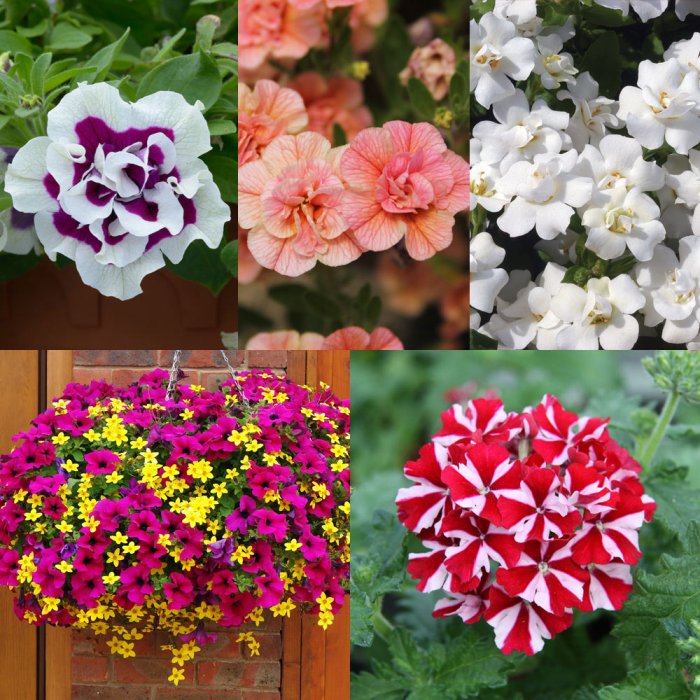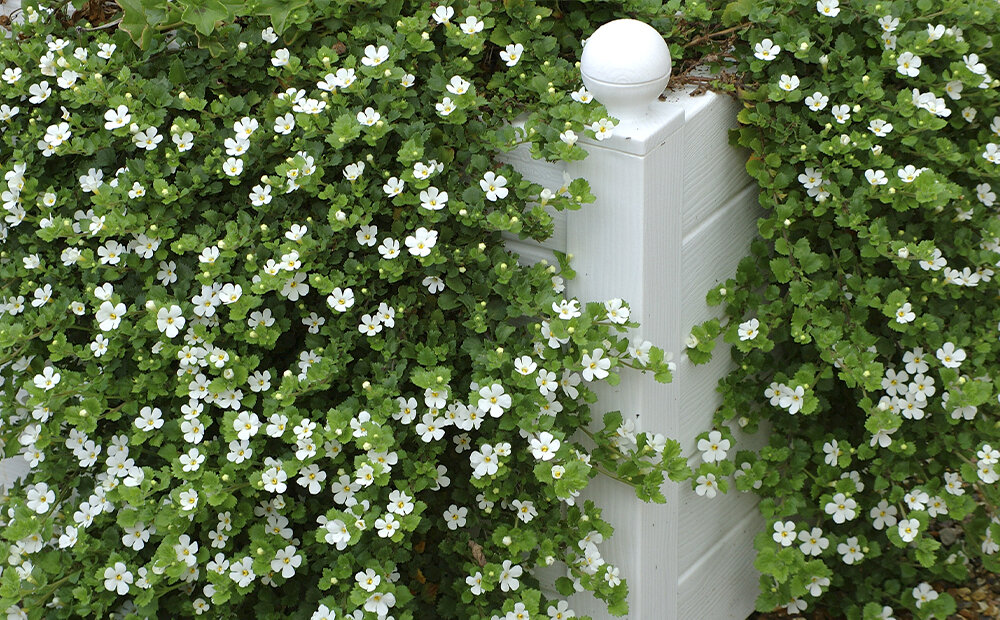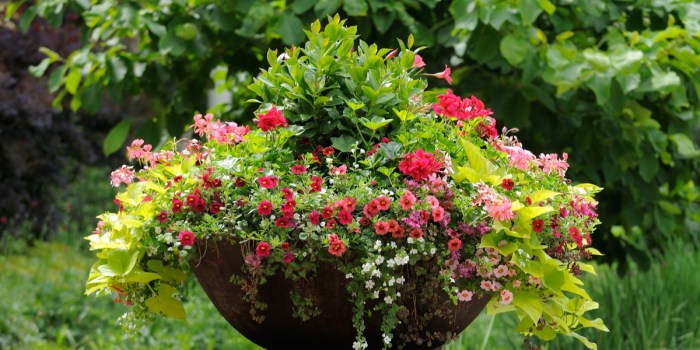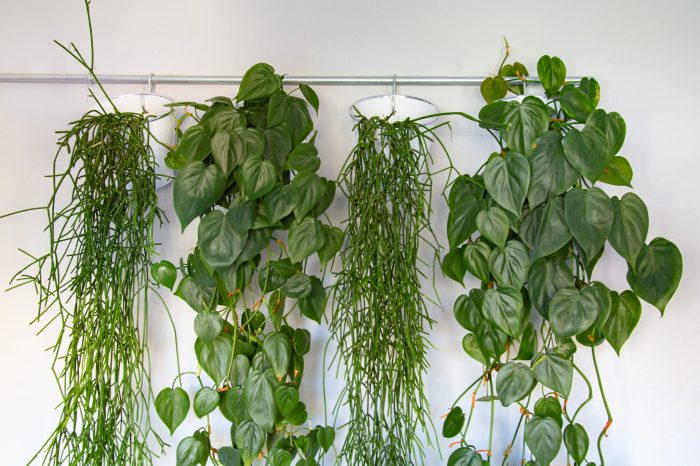Beautiful trailing plants are a captivating addition to any indoor or outdoor space, adding a touch of elegance and natural beauty. Their cascading foliage creates a stunning visual effect, bringing a sense of tranquility and charm to any environment.
From lush ferns to vibrant succulents, there’s a wide variety of trailing plants to choose from, each with its own unique growth habit and foliage. Whether you’re looking to create a vertical garden, add a splash of color to your patio, or simply bring some greenery into your home, trailing plants offer endless possibilities.
Plant Types

Trailing plants, also known as cascading plants, are a diverse group of species that add a touch of elegance and drama to any indoor or outdoor space. Their cascading growth habit and lush foliage make them perfect for hanging baskets, windowsills, or trellises.
Here is a table listing some of the most popular trailing plants, along with their botanical names, growth habits, and foliage:
| Name | Botanical Name | Growth Habit | Foliage |
|---|---|---|---|
| English Ivy | Hedera helix | Vining | Deep green, lobed leaves |
| Pothos | Epipremnum aureum | Vining | Heart-shaped leaves with variegated patterns |
| Spider Plant | Chlorophytum comosum | Rosette-forming | Long, arching leaves with variegated stripes |
| String of Pearls | Senecio rowleyanus | Trailing | Small, round leaves that resemble pearls |
Care Requirements: Beautiful Trailing Plants

Trailing plants, known for their cascading foliage and graceful appearance, require specific care to thrive indoors. Understanding their ideal lighting conditions, watering needs, and temperature range is crucial for their well-being. Additionally, being aware of common pests and diseases that can affect them allows for prompt prevention and treatment.
Lighting
Trailing plants generally prefer bright, indirect light. Direct sunlight can scorch their leaves, while low light conditions can stunt their growth. East- or west-facing windows provide optimal lighting for most species.
Watering
Water trailing plants thoroughly when the top inch of soil feels dry to the touch. Avoid overwatering, as this can lead to root rot. Allow excess water to drain from the pot and never let the plant sit in water.
Enhance your home décor with beautiful trailing plants that cascade gracefully from 8 Inch Hanging Planters . These versatile additions provide a touch of greenery and elegance, creating a vibrant and inviting atmosphere in any room. From lush ferns to trailing succulents, there’s a trailing plant perfect for every space, adding a touch of natural beauty and tranquility to your home.
Temperature
Trailing plants prefer warm temperatures between 65-80°F (18-27°C). Avoid exposing them to cold drafts or sudden temperature fluctuations.
Common Pests and Diseases
Trailing plants can be susceptible to pests such as aphids, mealybugs, and spider mites. Diseases like powdery mildew and root rot can also affect them. Regular inspection and prompt treatment with appropriate insecticides or fungicides is essential for maintaining plant health.
Care Summary Table
| Lighting | Watering | Temperature |
|---|---|---|
| Bright, indirect light | Water when top inch of soil is dry | 65-80°F (18-27°C) |
Propagation Methods

Trailing plants are popular for their ability to add a touch of greenery and elegance to any space. Propagating trailing plants is a relatively easy process that can be done using various methods, including stem cuttings, division, and layering. Each method has its own advantages and disadvantages, and the best method for you will depend on the specific plant you are trying to propagate.
The best time of year to propagate trailing plants is during the growing season, which is typically spring and summer. This is when the plants are actively growing and have the most energy to produce new roots.
Stem Cuttings, Beautiful trailing plants
Stem cuttings are the most common method of propagating trailing plants. To take a stem cutting, simply cut a 4- to 6-inch piece of stem from a healthy plant. Remove the leaves from the bottom inch or two of the stem, and then dip the end of the cutting in rooting hormone.
Plant the cutting in a pot filled with a well-draining potting mix, and keep the soil moist. The cutting should root in 2 to 3 weeks.
Division
Division is another easy method of propagating trailing plants. To divide a plant, simply dig it up and carefully divide the root ball into two or more pieces. Each piece should have its own roots and stems. Replant the divisions in separate pots, and water them well.
The divisions should establish themselves quickly and start growing new leaves.
Layering
Layering is a method of propagating trailing plants that involves rooting a stem while it is still attached to the parent plant. To layer a plant, simply bend a stem down to the ground and cover it with soil. The stem will eventually root, and you can then cut it away from the parent plant and plant it in a new pot.
Display Ideas

Showcase the beauty of trailing plants by using creative display ideas that enhance their natural allure. From hanging baskets to trellises and beyond, explore a range of options to bring these cascading plants to life.
These ideas not only add aesthetic appeal but also provide support and structure for the plants to thrive. Consider the following suggestions for indoor and outdoor settings:
Hanging Baskets
- Suspend trailing plants in hanging baskets for a dramatic vertical display.
- Choose baskets with drainage holes to prevent waterlogging.
- Line baskets with moss or coconut fiber to retain moisture.
- Use S-hooks or chains to securely hang baskets from ceilings, walls, or hooks.
- Consider cascading varieties such as ivy, ferns, or petunias for a flowing effect.
Image: A hanging basket filled with lush green ivy cascading over the sides.
Trellises and Arbors
- Provide support and structure for trailing plants with trellises or arbors.
- Choose trellises made of wood, metal, or bamboo for durability.
- Train plants to climb up the trellis using twine or wire.
- Create a living wall or privacy screen by planting trailing plants along a trellis.
- Consider varieties like clematis, honeysuckle, or morning glories for their showy blooms and climbing abilities.
Image: A trellis adorned with blooming clematis, creating a vibrant and fragrant display.
Other Creative Structures
- Use macrame hangers or plant stands to suspend trailing plants in unique ways.
- Create a living chandelier by hanging multiple plants from a central point.
- Train plants to cascade over windowsills or shelves for a natural and elegant touch.
- Consider using old ladders, crates, or even bicycles as creative display structures.
- Experiment with different textures and colors of plants to create a visually captivating display.
Image: A macrame hanger suspending a trailing fern, adding a bohemian touch to the room.
Beautiful trailing plants add a touch of elegance and greenery to any indoor space. Their long, cascading vines create a dramatic effect that can instantly transform a room. If you’re looking for inspiration on how to incorporate trailing plants into your home decor, be sure to check out Plants Indoor for a wide selection of trailing plants and expert advice on how to care for them.
With the right care, these beautiful plants can thrive indoors and bring years of enjoyment.
Companion Plants

Trailing plants can enhance the beauty of any garden or indoor space, but they can also benefit from the company of companion plants. Companion planting is the practice of growing different plant species together to create a mutually beneficial relationship.
By carefully selecting companion plants, gardeners can improve the growth, health, and appearance of their trailing plants.
Beautiful trailing plants not only add a touch of greenery to your home but also purify the air. For those looking to improve indoor air quality while enhancing aesthetics, Air Purifying Hanging Plants: Enhancing Indoor Air Quality and Aesthetics offers a comprehensive guide to the best air-purifying hanging plants.
With their cascading foliage and ability to remove toxins from the air, these plants provide both beauty and health benefits, making them an ideal choice for any home.
Suitable Companion Plants
When choosing companion plants for trailing plants, several factors should be considered, including size, growth habit, and flowering time. Smaller companion plants that do not compete for light or space are ideal, while those with a similar growth habit can help to support and anchor trailing plants.
Additionally, companion plants that bloom at different times can extend the overall flowering period of the garden.
Examples of Successful Combinations
Some successful companion plant combinations for trailing plants include:
- *Trailing petunias with
- *Trailing verbena with
- *Trailing lobelia with
-*upright snapdragons
The upright snapdragons provide support for the trailing petunias, while the petunias add color and fill in the gaps at the base of the snapdragons.
-*low-growing salvia
Whether you’re a seasoned plant enthusiast or just starting your indoor gardening journey, beautiful trailing plants can add a touch of elegance and tranquility to your living spaces. If you’re looking for a way to elevate your interiors even further, consider incorporating large indoor hanging pots.
Elevate Your Interiors with Large Indoor Hanging Pots: A Comprehensive Guide offers valuable insights into selecting the perfect hanging pots, choosing suitable plants, and maintaining their beauty. With this guide, you can create a lush and inviting atmosphere that will bring a touch of nature indoors while adding a unique and stylish element to your home.
The low-growing salvia provides a colorful groundcover beneath the trailing verbena, while the verbena adds height and interest to the planting.
-*alyssum
The alyssum forms a dense, low-growing mat that complements the trailing lobelia, while the lobelia adds a splash of color and attracts pollinators.
Benefits of Companion Planting
Companion planting offers several benefits for trailing plants, including:
-
-*Improved growth and vigor
Companion plants can provide support and protection for trailing plants, helping them to grow more vigorously and produce more flowers.
-*Reduced disease and pest problems
Some companion plants have natural pest-repellent properties that can help to protect trailing plants from pests and diseases.
-*Enhanced aesthetics
Companion plants can create a more visually appealing display by adding color, texture, and interest to the garden.
| Trailing Plant | Companion Plant | Benefits |
|---|---|---|
| Trailing petunias | Upright snapdragons | Support, extended flowering period |
| Trailing verbena | Low-growing salvia | Groundcover, color |
| Trailing lobelia | Alyssum | Groundcover, pollinator attraction |
Closure
Incorporating beautiful trailing plants into your décor is a simple yet effective way to enhance the aesthetics of your space. Their graceful foliage and versatility make them ideal for a wide range of applications, from creating living walls to adorning hanging baskets.
Embrace the beauty of trailing plants and let their natural charm transform your surroundings into a vibrant oasis.
Frequently Asked Questions
What are the most popular trailing plants?
Some of the most popular trailing plants include English ivy, pothos, spider plants, and trailing succulents like sedum and echeveria.
How much light do trailing plants need?
Most trailing plants prefer bright, indirect light, but some can tolerate low light conditions.
How often should I water trailing plants?
Water trailing plants when the soil feels dry to the touch, but avoid overwatering.